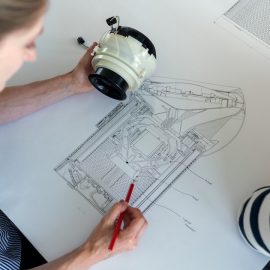

This article is an excerpt from the Shortform book guide to "Who" by Geoff Smart and Randy Street. Shortform has the world's best summaries and analyses of books you should be reading.
Like this article? Sign up for a free trial here.
What interview rubric for hiring should you follow? What types of questions should you answer as an interviewer?
The first step in the hiring process is creating a hiring rubric when a role opens. This rubric lists the role’s important responsibilities, as well as abilities and traits that can help the employee complete those responsibilities.
Here’s how to fill out your interview rubric.
Create a Hiring Rubric
An interview rubric for hiring gives you an easy reference for the rest of the hiring process to ensure your candidates will be able to properly fill said role.
(Shortform note: The hiring rubric the authors describe is similar to a role description on a job listing. Thus, HR experts’ advice on writing job descriptions may help when crafting a rubric. While they don’t recommend creating a new description every time a role opens, they do suggest updating each description when the employee in that role has their annual performance review. This keeps the description up-to-date and lets you use it to evaluate the employee’s performance. Unlike Smart and Street, these experts don’t pay equal attention to responsibilities, traits, and abilities. Instead, they suggest briefly listing the minimum skill level required and then going into greater detail about the responsibilities—like sharing the percentage of time an employee would spend on each—so candidates fully understand the role.)
We’ve arranged the authors’ advice under three questions you can answer to identify these responsibilities, abilities, and traits:
Question #1: What’s the Role’s Purpose?
The first question you should answer when making your hiring rubric is “what’s the role’s current purpose?” This is an important question, as the company may prioritize different responsibilities, abilities, and traits from the same role at different points in time. This specificity encourages candidates with relevant skills and experience to pursue the role. It also reminds you to look for those specific attributes, instead of accepting candidates who are skilled generally but not in the ways you currently need.
Continuing our example, in a period of rapid growth, you may need a manufacturing manager who can quickly increase output and efficiency. However, when interviewing candidates, you focus on their general management experience, rather than the specific skills you need. Thus, you end up hiring a manager who’s fantastic at giving feedback and improving quality but who can’t deliver the rapid output and efficiency improvements you need.
When defining the role’s purpose, the authors say to keep your description short and use simple language instead of jargon. This ensures that both you and your candidates can easily understand the role’s purpose. The authors also indicate that your description should include the general approach an employee would take to fulfill the role’s purpose and a broad timeline for doing so.
For example, if the role’s purpose is increasing output, your description may be, “The manufacturing manager will increase output by 50% over four years by hiring additional teams and training existing teams.” This would encourage candidates who have experience with rapid growth and training employees to pursue the role, and it reminds you to specifically look for candidates with this prior experience.
Question #2: What Are the Role’s Main Goals?
Once you’ve defined the role’s purpose, the second question you should answer is “what are the role’s main goals?” The authors say most roles have three to eight of these. By answering this question, you provide a more detailed explanation of what a candidate must do to successfully fulfill the role’s purpose. In other words, the purpose is the end-point, and the goals are the steps to reach it. These goals clarify your expectations for an employee in the role, so both you and your candidates can evaluate whether they could successfully meet those expectations.
Thus, ensure these goals are clear, objectively measurable, and have specific deadlines. Continuing our example, two of your manufacturing manager’s goals may be: “Create an efficiency improvement training program by the end of year one” and “Increase efficiency by 20% by the end of year two.”
The authors emphasize that these goals are different from the daily tasks an employee in the role would complete. An employee’s daily tasks (for example, leading meetings or giving feedback to subordinates) are how the employee reaches their goals, not the goals themselves.
Question #3: What Qualities Are Important in This Role?
The third question you should answer is “what qualities are important in this role?” By answering this question, you identify traits or abilities that you want an employee in the role to display. Much like the previous questions, this encourages people with those qualities to pursue the role and reminds you to look for those qualities when interviewing (which we’ll discuss further in a later section).
To answer this question, consider what qualities may help an employee fulfill the role’s purpose and goals, as well as qualities that fit broader, companywide goals for employee behavior. For instance, you may list “skilled at providing feedback” for the role of manufacturing manager, since they need that skill to complete their managerial responsibility. You may also include “curiosity” as a trait that you want every member of the company to have, if the company relies on continual experimentation and innovation to stay at the forefront of its industry.
The authors caution against being too specific with your desired qualities, though. People with different qualities can achieve equal levels of success, so you don’t want to limit your candidate pool too much and overlook candidates who could excel in the role, albeit in a different way than you anticipated. For instance, say you specified that the manufacturing manager needs to be “skilled in providing feedback through written evaluations.” You then dismiss a candidate who’s skilled in providing feedback verbally. That candidate could’ve been successful in the role, but you lost the opportunity because of your narrow focus.

———End of Preview———
Like what you just read? Read the rest of the world's best book summary and analysis of Geoff Smart and Randy Street's "Who" at Shortform.
Here's what you'll find in our full Who summary:
- Why the key to business success is having an effective hiring process
- The 4-step hiring process you should be following
- The two behavioral tendencies to look out for in candidates






